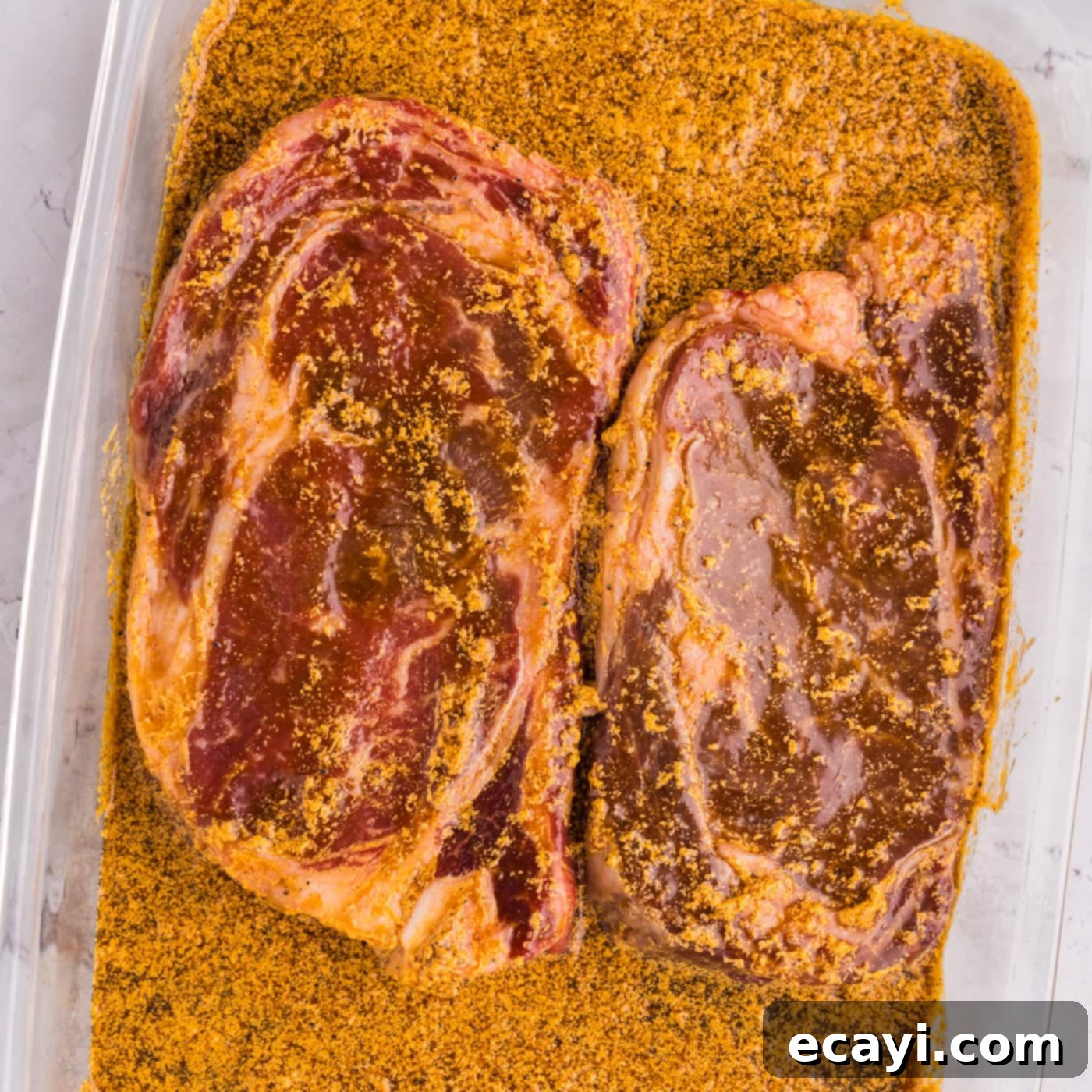The Ultimate Ribeye Steak Marinade: Unlock Unforgettable Flavor and Tenderness
A truly exceptional ribeye steak transcends a simple cut of meat; it’s an experience. And while a ribeye is inherently flavorful and tender, the right marinade can elevate it to an extraordinary level, infusing it with layers of taste and ensuring an unparalleled juicy, succulent bite every single time. Our carefully crafted ribeye steak marinade is packed with robust, mouth-watering components designed to not only deepen the steak’s flavor but also enhance its natural tenderness and moisture, guaranteeing a meal that will impress even the most discerning palates.
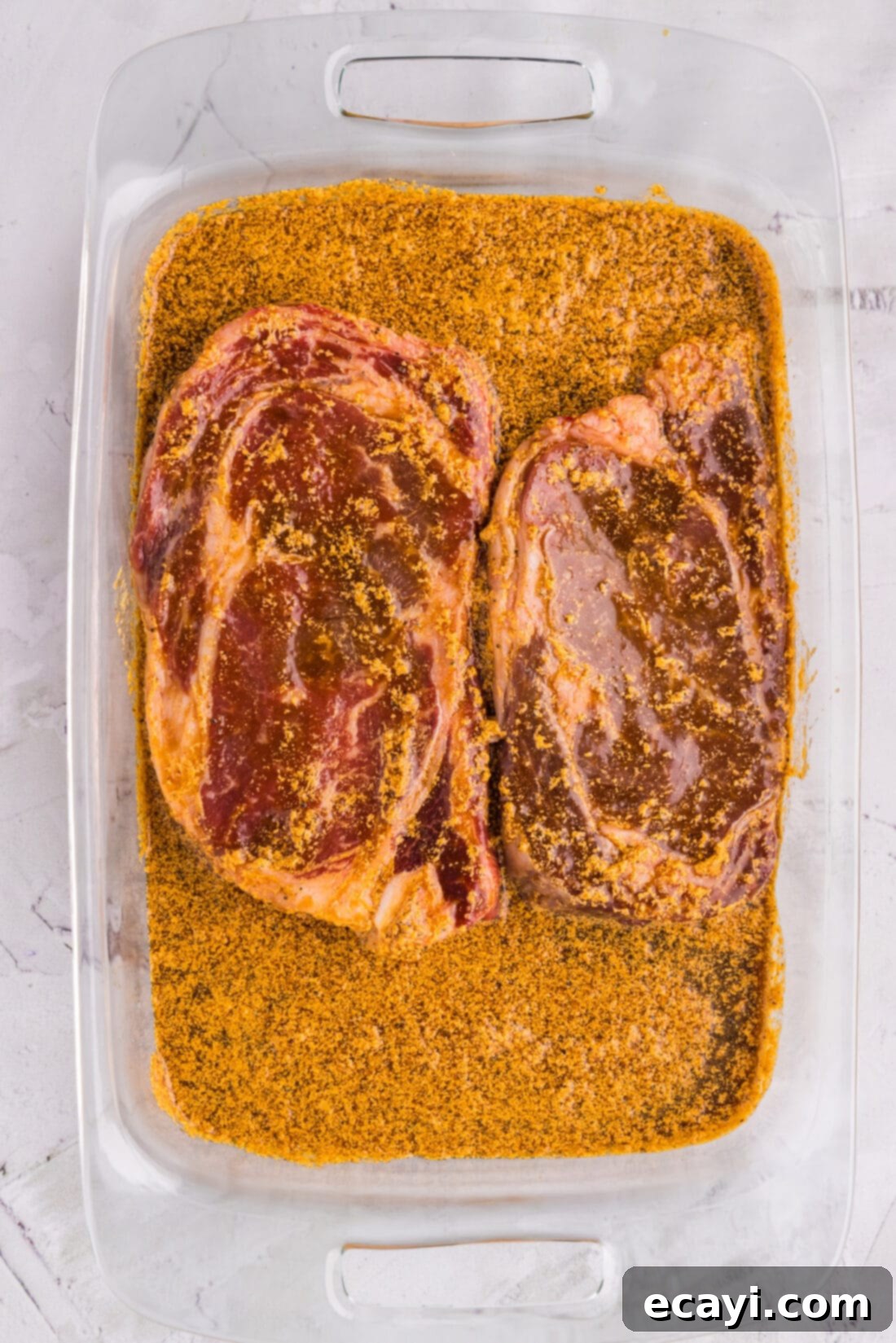
Why This Ribeye Steak Marinade Recipe is a Game-Changer
Achieving a perfectly juicy and tender ribeye steak isn’t solely dependent on your cooking method. While searing and grilling play a vital role, the secret often lies in a powerful marinade that works behind the scenes to prepare the meat for its culinary destiny. This particular ribeye steak marinade stands out because it leverages a strategic blend of ingredients to tenderize the beef and imbue it with an incredible depth of flavor.
Our recipe thoughtfully combines the savory richness of soy sauce and Worcestershire, the bright acidity of lemon juice, a carefully selected array of warming spices, and a hint of hot sauce and brown sugar. Each component plays a crucial role: soy sauce delivers a foundational umami and saltiness, while Worcestershire adds a complex, tangy depth. Lemon juice acts as a natural tenderizer, gently breaking down meat fibers without making the steak mushy. The spices (chili powder, garlic salt, onion powder, and black pepper) create an aromatic, savory base, and the brown sugar balances the acidity while promoting beautiful caramelization during cooking. Finally, a touch of hot sauce adds a subtle, intriguing kick that elevates the overall profile.
While marinating a premium cut like ribeye isn’t strictly necessary for tenderness—it’s already a tender cut—it absolutely transforms the eating experience. It’s the difference between a good steak and an unforgettable one, adding layers of gourmet flavor that simple salt and pepper can’t achieve. Think of it as an upgrade, enhancing the steak’s natural qualities rather than just masking them.
This marinade builds upon the success of our popular general steak marinade, but with key innovations specifically tailored for ribeye. The most notable change is swapping traditional oil for butter. Unlike oil, which tends to run off the surface of the meat, butter clings beautifully, ensuring that all those incredible flavors are absorbed consistently throughout the entire marinating process. Furthermore, the inclusion of hot sauce and brown sugar introduces a delightful sweet-and-spicy dynamic that not only creates a succulent crust when cooked but also enhances the overall richness and complexity of the ribeye.
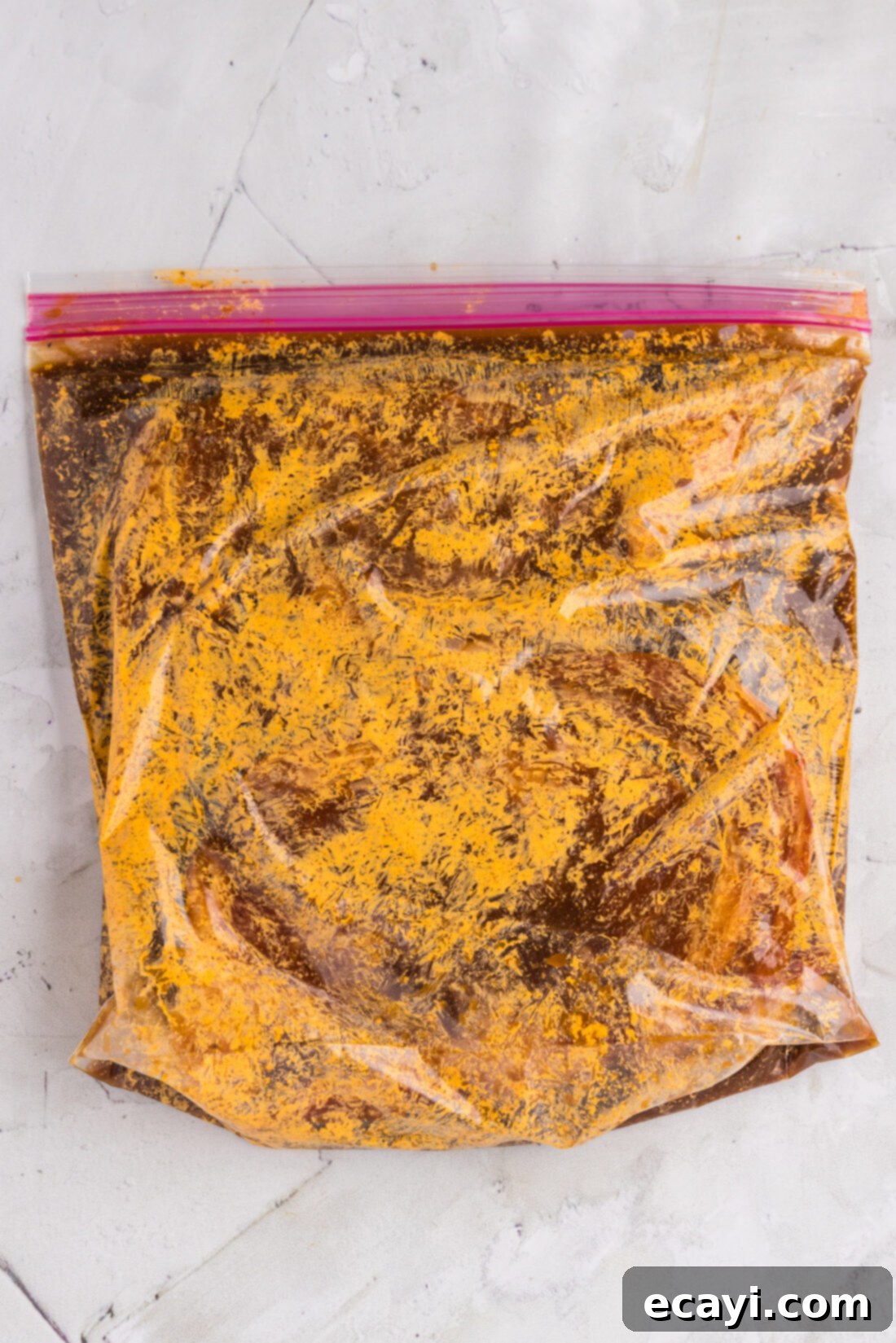
Key Ingredients for Your Flavorful Ribeye Steak Marinade
To craft this incredible ribeye marinade, you’ll need a selection of pantry staples and a few special additions that work in harmony to create a symphony of flavors. Below is a detailed list of the ingredients. For precise measurements and the full printable recipe, please refer to the recipe card at the bottom of this post.
- Soy Sauce: The foundation for umami and savory depth.
- Lemon Juice: Essential for tenderizing and brightening flavors.
- Worcestershire Sauce: Adds a complex, tangy, and slightly sweet note.
- Butter: For rich flavor infusion and adherence to the steak.
- Chili Powder: A warm, earthy spice blend.
- Garlic Salt: Provides both savory garlic flavor and necessary seasoning.
- Onion Powder: Sweet, savory onion notes without the moisture of fresh onion.
- Brown Sugar: Balances acidity and aids in caramelization.
- Minced Garlic: Fresh aromatic flavor.
- Frank’s Red Hot Sauce: For a pleasant kick and tang.
- Black Pepper: Classic seasoning to round out the spice profile.
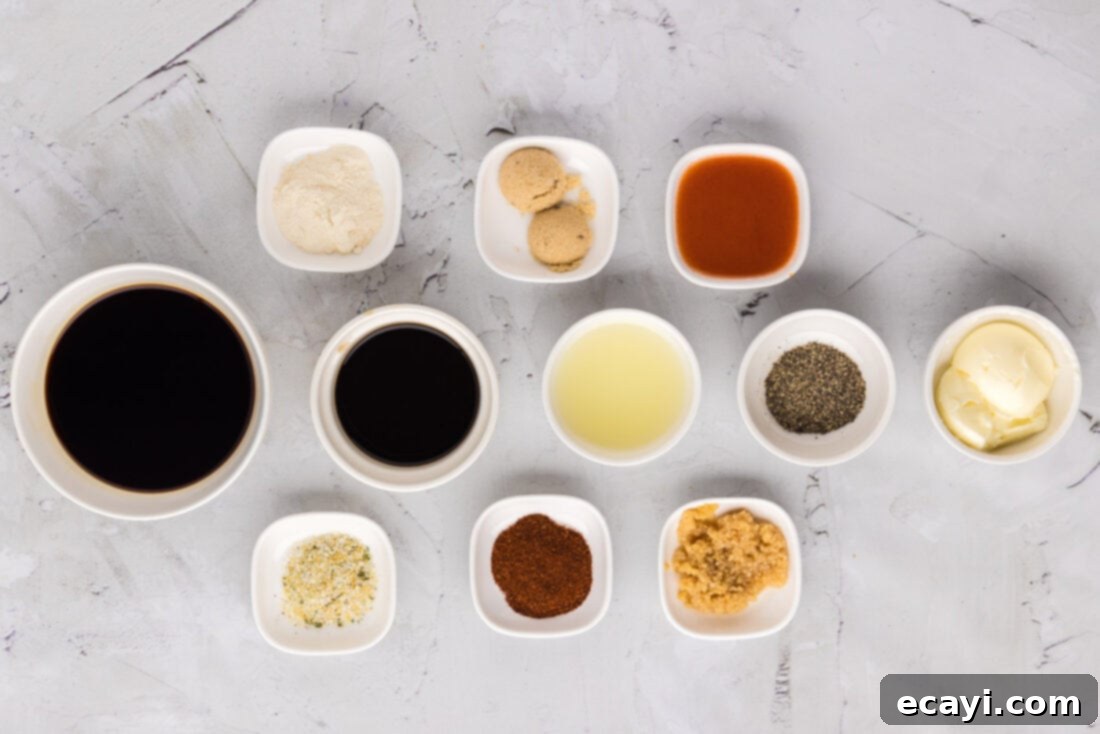
Ingredient Spotlight & Expert Substitution Advice
Understanding each ingredient’s role allows for mastery over the recipe and smart substitutions when needed:
LEMON JUICE – Lemon juice is not just for a bright citrusy flavor; it’s a critical component in this marinade for its acidic properties. The acidity acts as a natural tenderizer, gently breaking down the tough muscle fibers in the beef. This process prevents your steak from becoming tough, ensuring a tender and palatable result as it rests in the marinade. You can substitute with lime juice or apple cider vinegar if lemon isn’t available, though the flavor profile will shift slightly.
BUTTER – Our secret weapon! Chef Antoine specifically uses butter in this marinade instead of conventional cooking oils, and for good reason. Unlike oil, which can easily slide off the meat, butter has a higher fat content and a more viscous texture that allows it to adhere directly to the steak’s surface. This means that all the incredible flavors within the marinade—the soy sauce, the spices, the hot sauce—are carried directly to the meat and deeply infused throughout the entire marinating period. Butter also contributes a rich, savory flavor that oil simply cannot replicate, leading to a more flavorful and succulent steak. For dairy-free options, a high-quality vegan butter substitute can work, though the nuanced flavor will be different.
SOY SAUCE – This provides the backbone of umami and salinity. It’s essential for a deep savory flavor. If you’re managing sodium intake, opt for a low-sodium soy sauce. Tamari is an excellent gluten-free alternative that offers a similar flavor profile.
WORCESTERSHIRE SAUCE – A complex condiment that adds a sweet, savory, tangy, and slightly spicy depth. It’s irreplaceable for its unique flavor. If you’re in a pinch, a very small amount of balsamic vinegar combined with a dash of soy sauce and a pinch of sugar might offer a faint resemblance, but it won’t be the same.
BROWN SUGAR – Don’t skip this! Brown sugar provides sweetness that perfectly balances the acidity of the lemon juice and the savory notes of the soy and Worcestershire. It also aids in creating that beautiful, caramelized crust during cooking. Honey or maple syrup can be used as alternatives, but adjust quantities to taste as their sweetness levels differ.
SPICES (Chili Powder, Garlic Salt, Onion Powder, Black Pepper) – This blend forms the aromatic and savory backbone of the marinade. Chili powder adds a warm, earthy heat; garlic salt provides a robust garlicky flavor and seasoning; onion powder contributes a sweet, savory onion note without the moisture of fresh onion; and black pepper adds a classic, pungent finish. Feel free to adjust the ratios to your preference, or add a pinch of smoked paprika for an extra layer of smoky flavor.
MINCED GARLIC – Freshly minced garlic offers the best, most pungent flavor. Pre-minced garlic from a jar can be used for convenience, but the flavor might be slightly muted. Always use fresh if you can!
FRANK’S RED HOT SAUCE – This adds a fantastic tangy heat that brightens the marinade without overpowering the other flavors. Its vinegary kick works well with the other acidic components. Any mild-to-medium heat hot sauce you prefer can be substituted, but Frank’s is recommended for its specific flavor profile.
Crafting Your Perfect Ribeye Steak Marinade: Step-by-Step Guide
These step-by-step photos and detailed instructions are here to help you visualize how to make this recipe with ease. You can Jump to Recipe to get the printable version of this recipe, complete with precise measurements and instructions at the bottom of this post.
- Combine Ingredients: Begin by gathering all your marinade ingredients. Add the soy sauce, lemon juice, Worcestershire sauce, softened butter, chili powder, garlic salt, onion powder, brown sugar, minced garlic, Frank’s Red Hot sauce, and black pepper into a bowl or the container of an immersion blender. Blend thoroughly until all ingredients are well combined and the mixture is smooth. This ensures that every flavor is fully integrated and ready to penetrate the steak.
- Marinate the Steaks: Pour the freshly blended marinade into a large glass dish or a sturdy plastic gallon-sized zipper bag. Place two ribeye steaks into the marinade, ensuring they are fully coated. If using a dish, flip the steaks occasionally or ensure enough marinade to submerge them completely. Seal the bag or cover the dish tightly and refrigerate for a minimum of 2 hours. For optimal flavor and tenderness, marinate for up to 12 hours. While marinating for longer (24-48 hours) is generally safe, for a naturally tender cut like ribeye, it risks making the meat mushy due to prolonged exposure to acidity. Always keep marinated steak refrigerated.
- Prepare for Cooking: Before cooking, remove the steaks from the marinade. Do not rinse them. Instead, pat them thoroughly dry on all sides with paper towels. This crucial step removes excess moisture, which is essential for achieving a beautiful, flavorful sear and crust. Let the steaks sit at room temperature, loosely covered with foil or plastic wrap, for about 20-30 minutes. This brings the meat closer to room temperature, ensuring more even cooking from edge to edge.
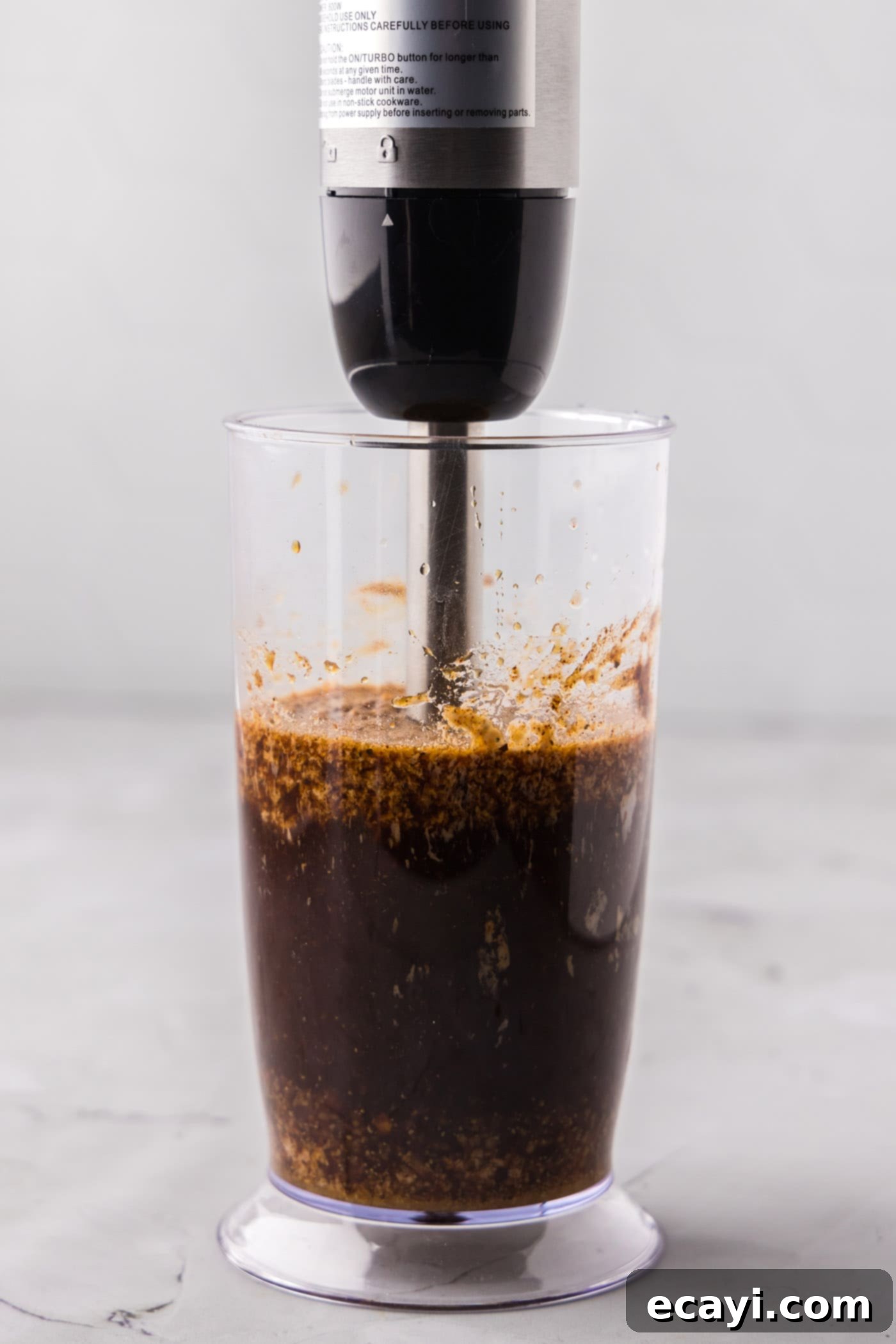
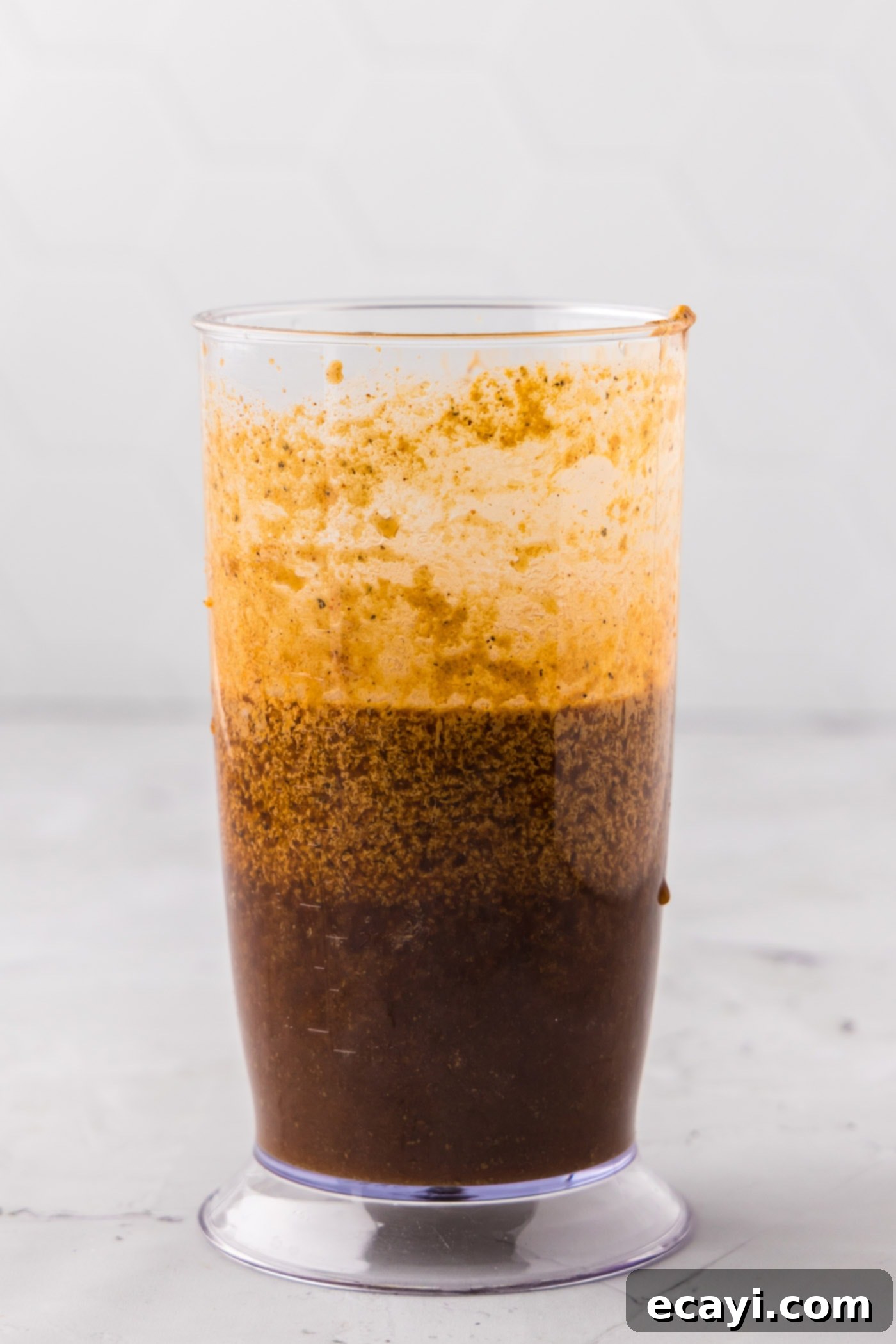
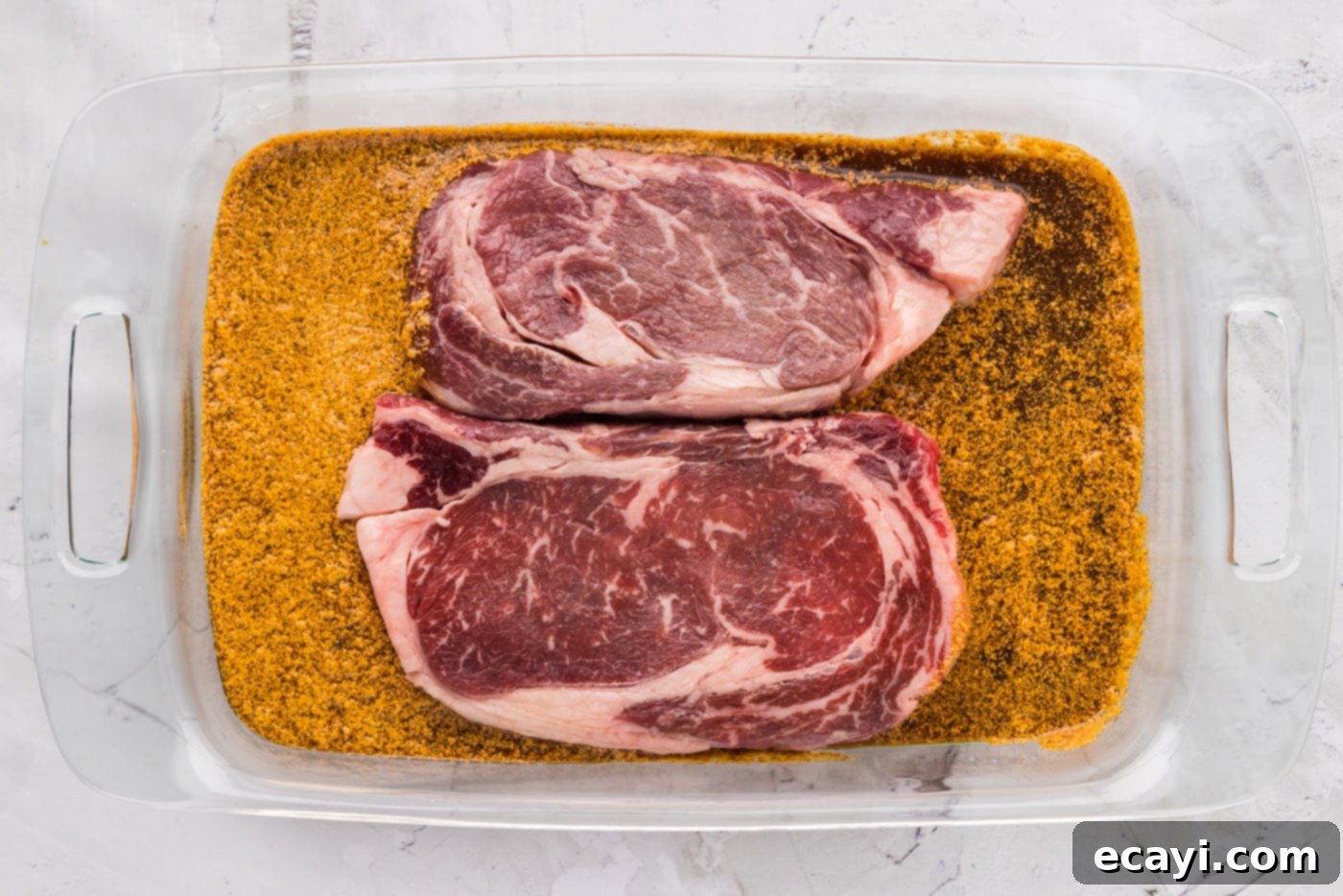
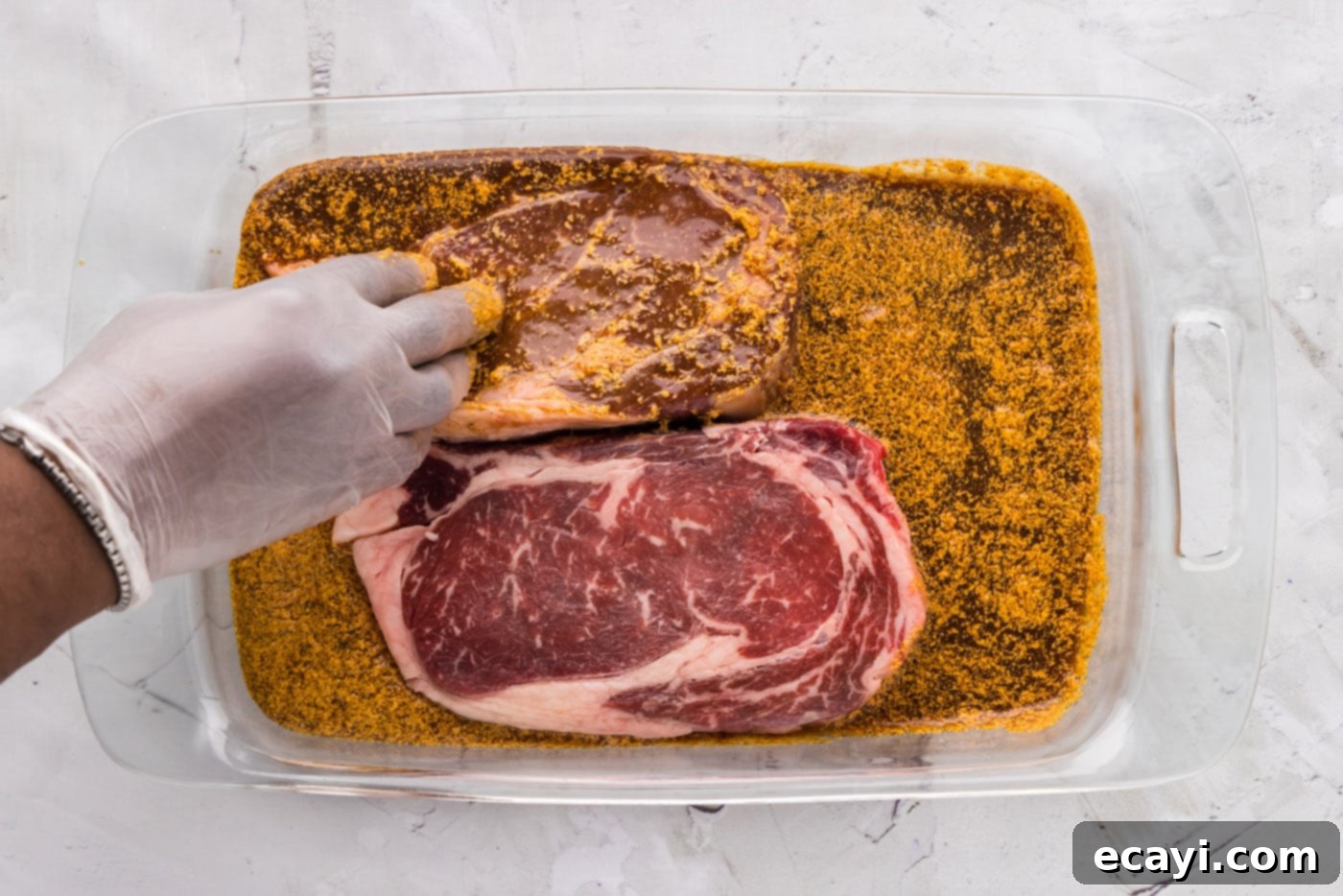
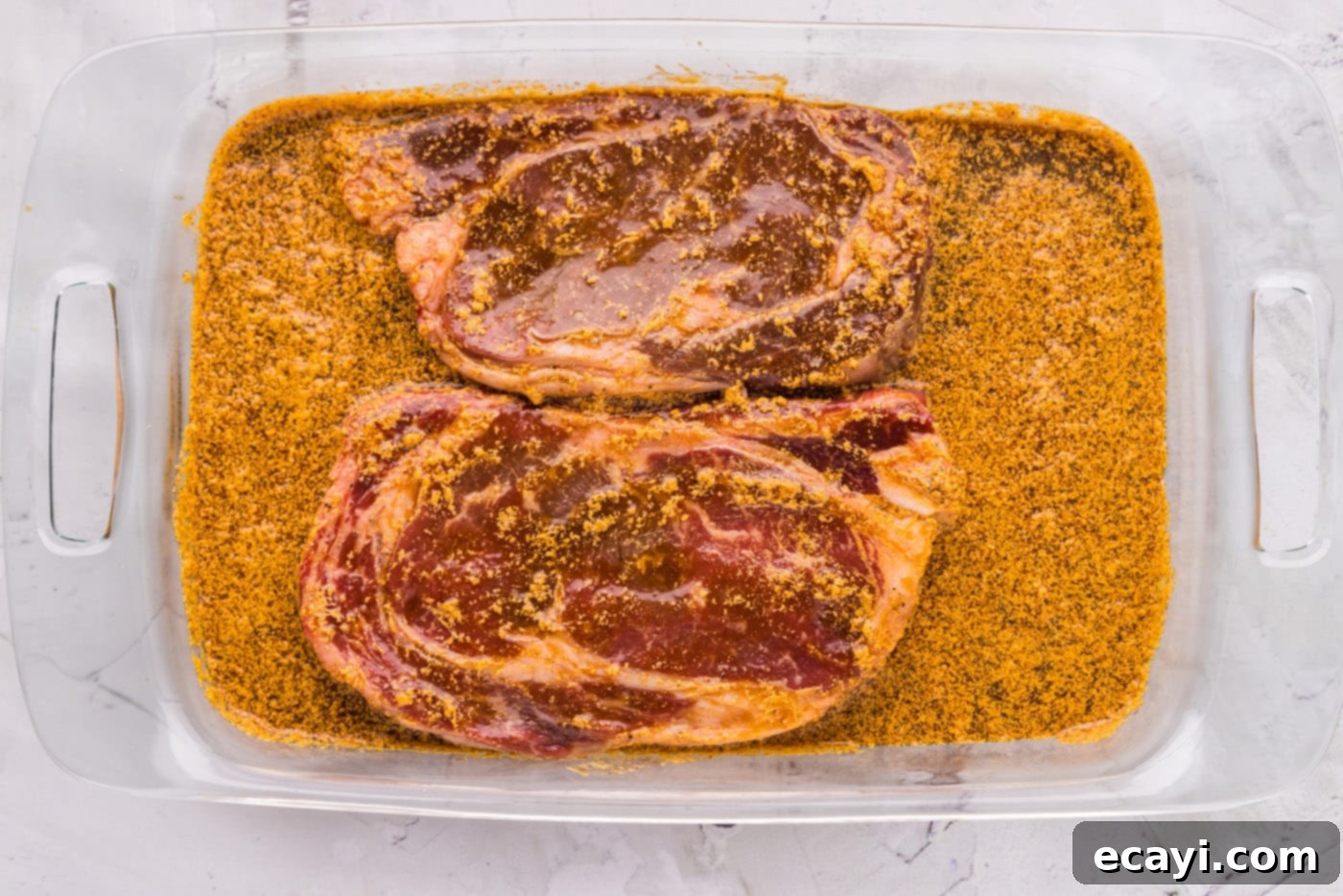
Frequently Asked Questions & Expert Tips for Perfect Steak
Absolutely! This versatile marinade is suitable for a wide variety of beef cuts. While specifically optimized for ribeye, it works wonderfully with other popular cuts such as sirloin, filet mignon, New York strip, T-bone, and even tougher cuts like flank steak or skirt steak. For tougher cuts, you might consider extending the marinating time slightly (up to 24 hours) to maximize the tenderizing effects of the lemon juice.
Yes, you can definitely prepare the marinade in advance! Simply whisk all the ingredients together as instructed, then store the marinade in an airtight container or a clean jar in the refrigerator. It will remain fresh and potent for 4-5 days, making it perfect for meal prepping or last-minute weeknight dinners.
For optimal results with ribeye, we recommend marinating for a minimum of 2 hours, and up to 12 hours. This timeframe allows the flavors to deeply penetrate the meat without compromising its texture. While it’s technically safe to marinate steak for longer (24 to 48 hours), extended exposure to the lemon juice’s acidity can, in some cases, cause the steak to become mushy or alter its texture due to over-tenderization. Since ribeye is already a naturally tender cut, a shorter marinating time is perfectly sufficient for flavor infusion and a slight tenderizing boost. Always ensure your marinated steak is stored in the refrigerator.
This marinade shines with high-heat cooking methods that promote a great sear and caramelization. Grilling is fantastic, creating delicious char marks and smoky flavor. Pan-searing in a cast-iron skillet followed by finishing in the oven is another excellent method for a perfect crust and even cooking. Broiling can also yield great results if you monitor it closely to prevent burning from the brown sugar in the marinade.
No, do not rinse the marinade off! Rinsing would wash away all the delicious flavors you worked so hard to infuse. The crucial step is to pat the steaks very dry with paper towels after removing them from the marinade. This removes surface moisture, which is essential for achieving a good sear and a crispy crust during cooking.
Yes, you can! This is a great meal prep hack. Place your steaks and the marinade in a freezer-safe zipper bag, ensuring to remove as much air as possible. Freeze for up to 3 months. When ready to cook, thaw the steak in the refrigerator overnight. It will continue to marinate as it thaws, making for an incredibly flavorful and convenient meal.
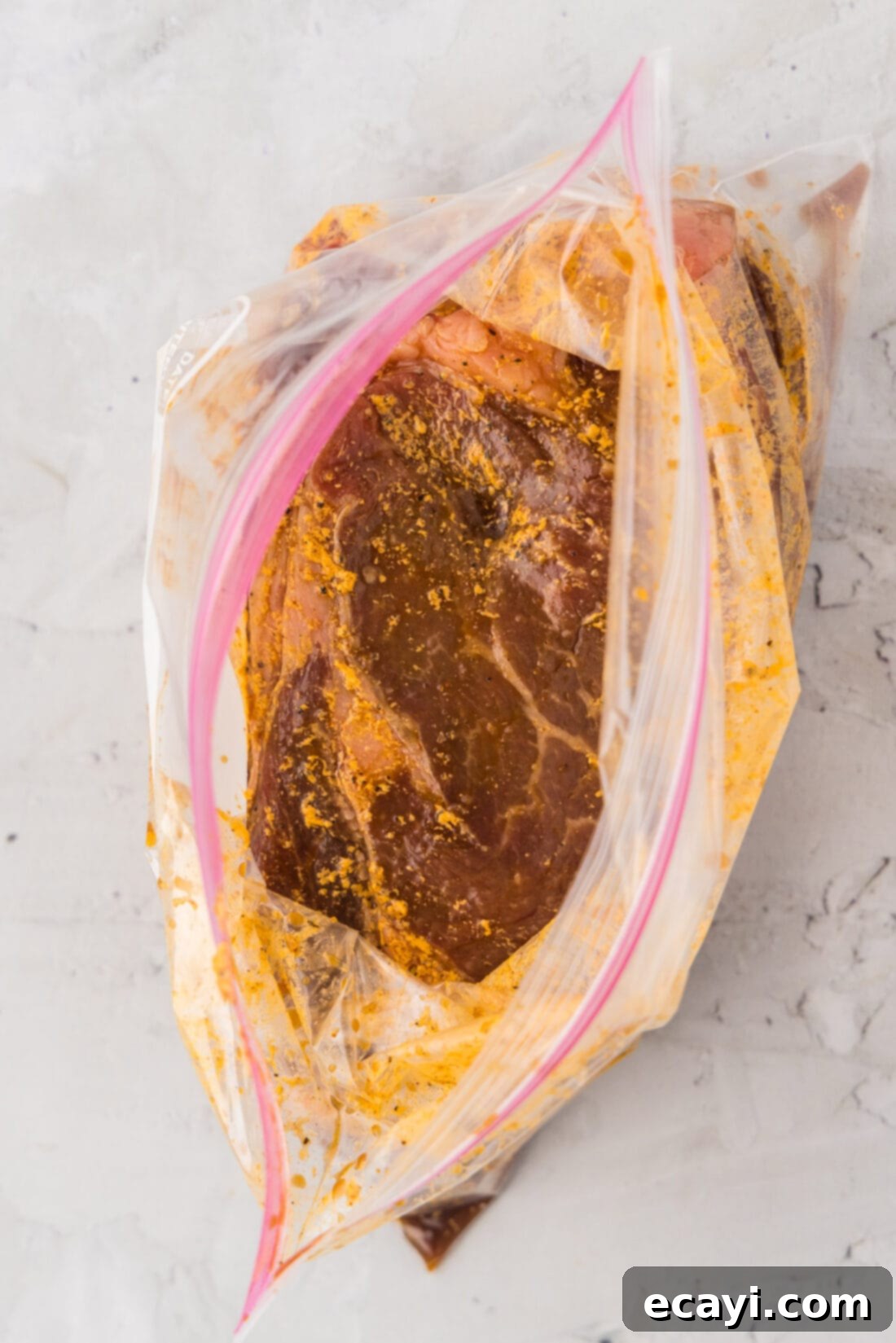
Serving Suggestions for Your Marinated Ribeye
This ribeye steak marinade recipe yields enough savory, tenderizing goodness for two generously sized steaks, ensuring each bite is packed with flavor. Remember, ribeye is already a king among steaks, renowned for its tenderness and marbling. This marinade simply enhances its natural qualities, making it even more exceptional. As noted, for ribeye, marinating for longer than 12 hours is usually unnecessary and can even be counterproductive. If, however, you choose to use this marinade on a tougher cut of meat like flank or skirt steak, feel free to extend the marinating time in the refrigerator for up to 24 hours to maximize its tenderizing benefits.
When it comes to serving your perfectly marinated and cooked ribeye, the possibilities are endless. Classic pairings that complement the rich, savory flavors of the steak include creamy garlic mashed potatoes, rich and comforting scalloped potatoes, or a vibrant side of roasted asparagus or Brussels sprouts. For a starter or lighter accompaniment, consider a comforting bowl of homemade French onion soup or a crisp, refreshing wedge salad. Don’t hesitate to experiment with your favorite sides; a well-marinated ribeye is incredibly versatile!
Explore More Delicious Steak Recipes
If you’re a steak enthusiast, be sure to check out these other fantastic steak recipes that cater to various cuts and cooking methods:
- Grilled Steak
- Oven Swiss Steak
- Reverse Sear Ribeye
- Smoked Ribeye Steak
- Bacon Wrapped Filet Mignon
- Bone in Ribeye
I love to bake and cook and share my kitchen experience with all of you! Remembering to come back each day can be tough, that’s why I offer a convenient newsletter every time a new recipe posts. Simply subscribe and start receiving your free daily recipes!
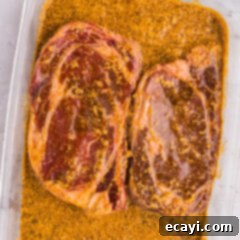
Ribeye Steak Marinade
IMPORTANT – There are often Frequently Asked Questions within the blog post that you may find helpful. Simply scroll back up to read them!
Print It
Pin It
Rate It
Save ItSaved!
Ingredients
- ½ cup soy sauce
- 1 Tablespoon lemon juice
- ¼ cup Worcestershire sauce
- 2 Tablespoons butter
- 2 teaspoons chili powder
- 1 teaspoon garlic salt
- 2 teaspoons onion powder
- 2 teaspoons brown sugar
- 1 Tablespoon minced garlic
- 1 Tablespoon Franks red hot sauce
- ½ teaspoon black pepper
Things You’ll Need
-
immersion blender
Before You Begin
- This marinade mixture makes enough for two nice sized ribeye steaks.
- Chef Antoine uses butter in his marinade rather than oil because it doesn’t break down. Butter sits on the meat, rather than sliding off like oil does which makes for a more flavorful steak.
- We recommend a minimum of 2 hours, or up to 12 hours using this recipe. Though it’s safe to marinate the steak for longer (24 hours to 48 hours) you can risk the steak becoming mushy from the acidity as it breaks down the fibers in the meat while it sits. Ribeye steak is rather tender all on its own, so adding a marinade simply aids in the flavor department, which means you don’t need to marinate for as long as some other cuts require. Always store marinated steak in the refrigerator.
- You can prepare the marinade ahead of time and store it in an air-tight container or jar kept in the refrigerator for 4-5 days.
- You can use any cut of steak you prefer with this marinade. Ribeye, sirloin, filet mignon, New York strip, strip steak, T-bone, and even flank steak can be used.
Instructions
-
Add all marinade ingredients to an immersion blender and blend to combine well until smooth.
-
Add marinade to a large glass dish or a plastic gallon zipper bag. Add 2 ribeye steaks, ensuring they are fully coated, and marinate in the refrigerator for a minimum of 2 hours, or up to 12 hours.
-
Remove meat from marinade and pat dry thoroughly with paper towels. Allow to sit at room temperature, covered loosely with foil or plastic wrap, for about 20-30 minutes before cooking for an even sear.
Nutrition
The recipes on this blog are tested with a conventional gas oven and gas stovetop. It’s important to note that some ovens, especially as they age, can cook and bake inconsistently. Using an inexpensive oven thermometer can assure you that your oven is truly heating to the proper temperature. If you use a toaster oven or countertop oven, please keep in mind that they may not distribute heat the same as a conventional full sized oven and you may need to adjust your cooking/baking times. In the case of recipes made with a pressure cooker, air fryer, slow cooker, or other appliance, a link to the appliances we use is listed within each respective recipe. For baking recipes where measurements are given by weight, please note that results may not be the same if cups are used instead, and we can’t guarantee success with that method.
